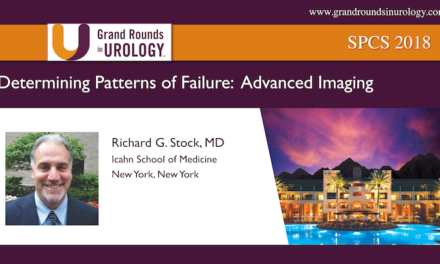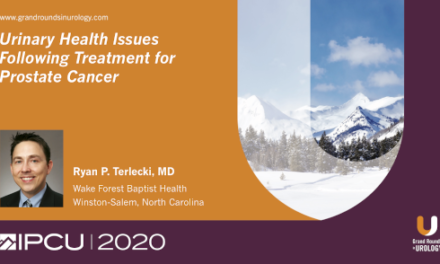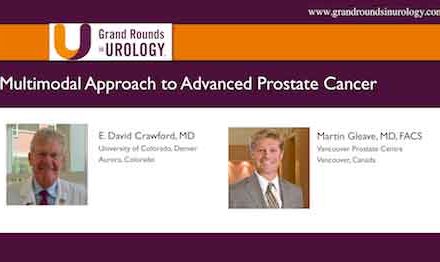Leonard S. Marks, MD, presented “Application of MRI Fusion Biopsy Results to Focal Therapy” during the Southwest Prostate Cancer Symposium 2020 virtual conference in December 2020.
How to cite: Marks, Leonard S. “Application of MRI Fusion Biopsy Results to Focal Therapy” December 2020. Accessed Nov 2024. https://dev.grandroundsinurology.com/application-of-mri-fusion-biopsy-results-to-focal-therapy/
Application of MRI Fusion Biopsy Results to Focal Therapy – Summary:
Leonard S. Marks, MD, Professor and inaugural holder of the deKernion Chair in Urology at the David Geffen School of Medicine at the University of California, Los Angeles, discusses focal therapy using MRI fusion biopsy and a novel process to determine tumor margins. He outlines the rationale for focal therapy, addresses previous concerns about the treatment, and discusses focal therapy failure and how to address it. Focal therapy is best used in intermediate-risk patients with localized lesions and should be conducted using MRI-guided biopsy. Dr. Marks identifies four reasons why focal therapy may fail: 1) heat sink effect from blood vessels surrounding the prostate; 2) field effect in which there is progression of low-risk cancer; 3) staging effect in which inaccurate localization leads to missing cancer cells; and 4) margin effect in which the satellite cancer area is missed. In the latter, MRI typically underestimates both tumor volume and tumor geometry. To address this, Dr. Marks describes a method to determine the tumor margins and create a customized treatment area by using biopsy cores and MRI. For a high-intensity focused therapy (HIFU) plan, the MRI visible treatment margin is used as a base and a paraboloid shape is then overlaid on the image. Then, the positive and negative biopsy site locations are overlaid and used as a guide to contract or expand the area. This process allows clinicians to spare the maximum amount of prostate tissue while not missing cancer cells. He emphasizes that doctors must take extra care to avoid the urethra when using HIFU. Dr. Marks then discusses hemi-gland ablation using HIFU and cryoablation. He concludes by highlighting the advantages of focal therapy, noting that it is safer than surgery or radiation, is effective, preserves options for further focal treatment or radical options if needed, and that patients prefer it.
About the Southwest Prostate Cancer Symposium 2020 virtual conference:
Presented by Program Chairs Nelson N. Stone, MD, and Richard G. Stock, MD, this virtual conference educated attendees about advances in the management of localized and advanced prostate cancer, with a focus on imaging, technology, and training in the related devices. It included a scientific session, as well as live demonstrations of surgical techniques. You can learn more about the conference, including the 2021 iteration, here.
ABOUT THE AUTHOR
Leonard S. Marks, MD, is Professor and inaugural holder of the deKernion Chair in Urology at the David Geffen School of Medicine at the University of California, Los Angeles. He graduated from the University of Texas Medical Branch, where he received his MD with AOA honors and his MA in Physiology in 1969. He served an internship and surgical residency at UCLA/Harbor General Hospital. For the following two years, he served on active duty as Lieutenant Commander in the US Public Health Service. He was named a Post-Doctoral Research Scholar at UCLA School of Medicine in 1973-4. He completed his Urology Residency at UCLA and was a Lecturer in Urology there in 1978, following which he entered private practice in Los Angeles. He re-joined the UCLA faculty full-time in 2009.
While in practice, Dr. Marks founded a non-profit research organization, the Urological Sciences Research Foundation, a 501c3 corporation, to further his academic interests. He became an original AFUD scholar in 1992 for work relating serum PSA levels to prostate histology. He received a Prostate Cancer Foundation (PCF) research award in 2000 for cross-cultural studies of prostate cancer. As an early advocate of multimedia in medical education, he served as Website Editor of Urology for The Gold Journal from 1998-2010. For his work in the scientific evaluation of alternative medicines, he was appointed to committees of the American Urological Association, the National Institutes of Health, and the National Academy of Sciences.
Over the past decade, he has been Principle Investigator of three separate R01 Awards from the National Cancer Institute devoted to targeted prostate biopsy and focal therapy of prostate cancer. He has authored more than 150 scientific publications.





